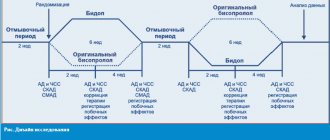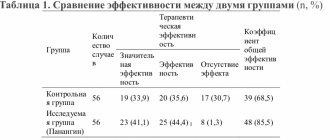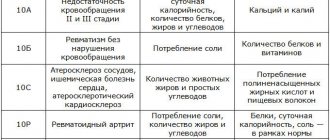Contraindications
Concor should not be used for the following diseases:
- cardiogenic shock;
- acute heart failure;
- chronic heart failure (CHF) in the stage of decompensation, which requires the use of inotropic therapy;
- sinoatrial block;
- atrioventricular (AV) block of II–III degree in patients without a pacemaker;
- severe bradycardia with heart rate less than 60 beats per minute;
- sick sinus syndrome;
- severe arterial hypotension [systolic blood pressure (BP) below 100 mmHg];
- Raynaud's syndrome or severe peripheral arterial circulation disorder;
- severe form of bronchial asthma;
- chronic obstructive pulmonary disease in severe form;
- metabolic acidosis;
- pheochromocytoma (without simultaneous use of alpha-blockers);
- age under 18 years;
- breastfeeding period;
- hypersensitivity to the components of the drug.
Special instructions for the use of the drug Bisoprolol-ratiopharm
Use with caution in patients with first degree AV block, cardiac and peripheral circulatory disorders, including Raynaud's disease and metabolic acidosis. β-adrenergic blockers may provoke or increase the frequency and duration of attacks of vasospastic angina/Prinzmetal angina. It is not recommended to prescribe the drug to patients with COPD or, if necessary, use it in lower doses (initial dose - 2.5 mg / day) in combination with bronchodilators. The drug should be used with caution in patients with diabetes mellitus with significant fluctuations in glycemic levels and metabolic acidosis. For the treatment of patients with severe pheochromocytoma, the drug is used only in combination with β-adrenergic receptor blockers. Bisoprolol-ratiopharm may mask the symptoms of thyrotoxicosis or hypoglycemia. At heart rate ≤50–55 beats/min per 1 min, the dose of the drug should be reduced. In congestive heart failure, it is necessary to evaluate the benefit/risk ratio due to possible inhibition of myocardial contractility. Treatment begins with a minimum dose of 2.5 mg. Bisoprolol-ratiopharm should be used with caution in patients with psoriasis, including a history of psoriasis. The drug may increase sensitivity to allergens and the severity of allergic reactions. In patients with coronary artery disease, sudden withdrawal of the drug may develop withdrawal syndrome. Therefore, drug withdrawal and dose reduction should be done gradually. Each tablet contains approximately 130 mg of lactose, each recommended dose contains 130–260 mg of lactose, which should be advised in patients with galactosemia or glucose/galactose malabsorption syndrome. The drug gives a positive result during doping control. During pregnancy, the use of the drug is possible only after a thorough assessment of the benefit/risk ratio for the mother and fetus. Given the lack of information regarding the content of the drug in breast milk, its use during breastfeeding is not recommended. The drug should not be prescribed to children under 12 years of age due to lack of experience in use. The drug does not affect the ability to drive vehicles or operate other machinery, but due to possible individual reactions, caution should be exercised when using the drug (especially at the beginning of treatment).
Doses and method of administration of Concor
Figure 2 - Dosage and method of use of the drug Concor
Concor is taken orally (do not chew or crush) once a day with a glass of water, regardless of meals. But there is a dependence on the time of day. The medicine should be taken exclusively in the first half of the day, that is, you cannot take Concor during the day, evening or at night.
As for the duration of therapy, it is determined by the body’s reaction and the decision of the attending physician.
- Arterial hypertension and angina pectoris
The dose of the drug is calculated taking into account the heart rate and general condition of the patient.
To begin with, Concor is prescribed 5 mg, one tablet per day. Then they go up to 10 mg. And in the treatment of hypertension and angina pectoris, the maximum recommended dose is 20 mg per day.
- Chronic heart failure without signs of exacerbation
Initially, 1.25 mg once a day. If the patient tolerates the dosage well, then it is gradually increased every two weeks to 2.5 mg, 3.75 mg, 5 mg, 7.5 mg and 10 mg.
If the dosage is poorly tolerated, then it should be reduced. The maximum recommended dose is 10 mg per day.
Pharmacological properties of the drug Bisoprolol-ratiopharm
Selective β1-adrenergic receptor blocker without BCA. Blocks β1-adrenergic receptors and reduces the effect of catecholamines on them. It has a hypotensive and antianginal effect. The hypotensive effect is due to a decrease in IOC, a decrease in sympathetic stimulation of peripheral vessels and inhibition of renin release by the kidneys. The antianginal effect is due to the blockade of β1-adrenergic receptors, which leads to a decrease in heart function due to negative chronotropic and inotropic effects. Thus, bisoprolol (INN - bisoprololum) eliminates or reduces the severity of symptoms of myocardial ischemia. Bisoprolol is almost completely (up to 90%) absorbed from the gastrointestinal tract. The effect of primary passage through the liver is very slight, due to which the drug has high bioavailability - about 90%. The half-life is 10–12 hours, which provides a therapeutic effect for 24 hours when taken once a day. More than 95% of the active substance is excreted by the kidneys, 50% unchanged. Active metabolites are not formed in the human body.
Side effects
Taking Concor may be accompanied by side effects:
- From the nervous system: increased fatigue, dizziness, headache, sleep disturbances, depression may be observed (especially at the beginning of therapy), rarely - hallucinations (usually mild and disappear within 1-2 weeks), sometimes - paresthesia.
- On the part of the organ of vision: visual disturbances, decreased tear production (must be taken into account when wearing contact lenses), conjunctivitis.
- From the cardiovascular system: in some cases - orthostatic hypotension, bradycardia, AV conduction disturbances, decompensation of heart failure with the development of peripheral edema, at the beginning of treatment - deterioration of the condition of patients with intermittent claudication or Raynaud's syndrome.
- From the respiratory system: in isolated cases - shortness of breath (in patients prone to bronchospasm).
- From the gastrointestinal tract: in some cases - diarrhea, constipation, nausea, abdominal pain, increased activity of liver enzymes in the blood serum (AST, ALT), hepatitis.
- From the musculoskeletal system: in some cases - muscle weakness, cramps, arthropathy affecting one or more joints (mono- or polyarthritis).
- From the endocrine system: decreased glucose tolerance (with latent diabetes mellitus) and masking of signs of hypoglycemia, in some cases - increased TG levels in the blood, potency disorders.
- On the skin: sometimes - itching, skin hyperemia, increased sweating, rash. When treated with beta-adrenergic receptor blockers, hair loss, hearing impairment or tinnitus, weight gain, mood changes, short-term memory loss, allergic rhinitis, and priapism are observed in some cases.
Concor during pregnancy
Figure 3 - Taking Concor during pregnancy
Expectant mothers should be extremely careful when choosing certain medications. In the case of Concor, you can take it only if the benefit to the mother’s body is greater than the damage. Concor should not be taken during lactation, since the baby receives bisoprolol and auxiliary components through breast milk. If discontinuation of the drug is not possible, then breastfeeding should be discontinued.
Bisoprolol - description and action
Bisoprolol tablets are an antihypertensive drug, widely used in the treatment of hypertension and a number of other diseases of the heart and blood vessels. The drug belongs to the group of selective beta blockers and is available in two dosages:
- 0.005 g (5 mg);
- 0.01 g (10 mg).
The product is produced by various pharmaceutical companies, “Pranapharm”, “Vertex”, “Atoll”, “North Star” and many others. The tablets are very inexpensive - in pharmacies you can find a pack of 30 pieces of 10 mg each for 40-50 rubles.
The composition of the drug is represented by the active substance - bisoprolol fumarate, a number of auxiliary components (magnesium stearate, cellulose, starch, colloidal dioxide).
It is not advisable to split the tablets, as they are film-coated.
Like other beta blockers, the drug has a positive effect on blood vessels in arterial hypertension. Its purpose is to relieve signs of high blood pressure, but the exact mechanism of operation has not yet been established. When taken, bisoprolol reduces the amount and activity of renin in the blood, and this leads to a decrease in the oxygen demand of the heart muscle. The pills also help slow down the heart rate. Thus, three main effects of the drug are achieved:
- hypotensive;
- antiarrhythmic;
- antianginal.
At the very beginning of taking the medicine, it causes an increase in general vascular resistance. After 1-3 days of use, the indicator returns to the original level, and then decreases even later. When taken regularly, Bisoprolol tablets help against hypertension in 2-5 days, and complete stabilization of blood pressure occurs in 30-60 days.
Concor is taken by many patients suffering from high blood pressure. The drug is no less often included in the prescriptions of cardiologists for coronary heart disease. Read more in the article: “Concor analogues and substitutes.”
Interaction with other drugs and alcohol
Figure 4 - Combination of Concor with other medications
The instructions for the drug Concor describe in some detail the compatibility with other drugs, because there is a list of drugs with which the Concor tandem is prohibited. Concor can be used in conjunction with analogues and generics, but such a combination must be discussed with your doctor so that an overdose does not occur and the blood pressure does not drop below normal levels.
Concor and Amlodipine
Amplodipine is an antihypertensive drug used for high blood pressure. The attending physician may prescribe a similar tandem if he believes that Concor will be ineffective. It is worth remembering that patients with heart failure cannot take Amplodipine and Concor together.
Concor and Arifon
Arifon - a diuretic indapamide - in combination with the beta blocker Concor is an effective complex in the treatment of hypertension. Concor lowers blood pressure, and Arifon reduces the volume of circulating blood, thus protecting the patient from signs of heart failure.
But Arifon has a side effect - it flushes potassium from the body, which can cause hypokalemia.
Concor and Lozap
The active substance of the drug Lozap, losartan potassium, is intended for the treatment of arterial hypertension. That is, it does not allow peripheral vessels to spasm and thereby does not allow blood pressure to rise. Concor and Lozap enhance each other's effects. Concor works to reduce cardiac output, while Lozap dilates arterioles and reduces peripheral pressure. As a result, blood pressure returns to normal.
The combination of drugs Concor and Lozap is most effective when the degree of arterial hypertension is quite high, and treatment with one drug is not so effective.
Concor and Enap
The simultaneous use of Concor and Enap or Enalapril, which are based on the same active ingredient - enalapril, should be prescribed with caution, since the drugs can enhance the effect of each other. So, the instructions say: with the simultaneous use of beta-blockers, methyldopa, nitrates, calcium channel blockers, hydralazine, prazosin, the antihypertensive effect may be enhanced. That is, blood pressure that is already lowered with the help of Concor can decrease further.
Enap is good for kidney disease, excess weight and a history of diabetes. Concor is indicated for use in patients with heart rhythm disturbances, tachycardia, and frequent attacks of angina. But if the resting heart rate is 50 - 60 beats/min, and there are conduction blockades, then you should take Enap, since Concor will only worsen these conditions.
The combined use of Concor and Enalapril lowers blood pressure and slows the progression of complications from the heart and kidneys. If you experience constant weakness, dizziness and fatigue during use, you should immediately inform your doctor.
Concor and Prestarium
Like all other ACE inhibitors, Prestarium goes well with the β1-blocker Concor. They are prescribed in tandem for high blood pressure, when the use of one drug is ineffective, reducing the risk of fatal complications for people with heart failure, obesity, diabetes, and chronic kidney disease.
But the decision to prescribe the combination Concor + Prestarium is made by the attending physician.
Prestarium itself is not as effective a medicine as Concor. If the pressure is 180/105 mmHg. Art., then it must be taken in combination with other drugs for hypertension.
Concor and Moxonidine
Concomitant use of Moxonidine with β-blockers such as Concor is not recommended. This can lead to a decrease in myocardial contractility and increased bradycardia
Concor and Lorista
Lorista is a generic version of the drug Lozap. That is, it contains the same active ingredient as the original drug, but it has not passed all stages of clinical trials. Generic status makes medicines cheaper without losing their properties. Lorista contains valsartan, a drug belonging to the group of sartans, which are prescribed for the development of a dry cough due to ACE inhibitors. The combination of Concor and Lorista is inferior in strength to the combination of Concor and any ACE inhibitor, since Lorista does not reduce the risk of complications of coronary artery disease.
Concor and alcohol
Figure 5 - Drinking alcohol with the drug Concor
It is known that when drinking alcohol, blood vessels dilate for a short time, that is, the heartbeat accelerates. True, after a short amount of time the opposite happens - vasospasm. And a sharp rise in blood pressure is not the most pleasant, but also not the most dangerous, thing that can await a patient taking Concor. The instructions directly state that Concor and alcohol are incompatible. The central nervous system is depressed, and the patient’s psychomotor abilities deteriorate. Also, do not forget that the medicine and alcohol will be excreted through one excretory system - the kidneys. This can lead to organ damage, and in some cases functional impairment may develop. Internal bleeding may begin, a hypertensive crisis, pulmonary edema, and vascular collapse may begin. But the worst result of taking Concor and alcohol together is death.
Therefore, doctors strongly recommend that you stop drinking alcohol while taking Concor.
Interactions of the drug Bisoprolol-ratiopharm
Combinations (due to the possibility of decreased activity) with floctafenine, sultopride, and MAO inhibitors (except MAO-B) are contraindicated. Allergens used for immunotherapy, allergen extracts for skin testing in combination with β-adrenergic receptor blockers can provoke the development of severe systemic allergic reactions. Combinations of bisoprolol with calcium antagonists (verapamil, diltiazem, bepridil) are not recommended/require special caution due to an increased negative effect on myocardial inotropic function, AV conductivity, and blood pressure. Drugs containing clonidine, reserpine, alpha-methyldopa should not be prescribed simultaneously with bisoprolol due to a possible slowdown in heart rate. Clonidine, digitalis, guanfacine can inhibit AV conduction. If combination therapy of bisoprolol with clonidine is discontinued, then after stopping clonidine, treatment with bisoprolol should be continued for several more days, ensuring medical monitoring of the patient's condition. Combinations requiring caution: class I antiarrhythmic drugs (eg disopyramide, quinidine, lidocaine, diphenine, propafenone); class III antiarrhythmic drugs (amiodarone, sotalol); calcium antagonists (dihydropyridine derivatives) - due to an increased risk of arterial hypotension and heart failure. The effect of insulin and oral hypoglycemic drugs may be enhanced when used simultaneously with bisoprolol. Cardiac glycosides: decrease in heart rate, prolongation of AV conduction. Baclofen: increased antihypertensive activity. Contrast agents containing iodine: β-adrenergic blockers may increase the risk of anaphylactic reactions. Drugs that block prostaglandin synthesis (in particular NSAIDs): decreased antihypertensive effect. Ergotamine derivatives: exacerbation of peripheral circulatory disorders. Sympathomimetic agents: combination with bisoprolol may reduce the effects of both drugs. Tricyclic antidepressants, barbiturates, phenothiazines, other antihypertensive drugs: enhance the effect of lowering blood pressure. Antihypertensive drugs (diuretics, ACE inhibitors, β-adrenergic receptor blockers) and nitrates potentiate the antihypertensive effect of bisoprolol. Corticosteroids: the antihypertensive effect may be reduced due to water and sodium retention. Inhalation anesthetics and hydrocarbon derivatives (chloroform, cyclopropane, halothane, methoxyfuran, etc.) when used simultaneously with β-adrenergic receptor blockers increase the risk of inhibition of myocardial function and the development of hypotensive reactions. The effect of depolarizing blockers of neuromuscular transmission can be enhanced and prolonged by the influence of beta-adrenergic receptor blockers. Cimetidine may reduce the clearance of β-adrenergic blockers that are metabolized in the liver and accordingly increase their bioavailability. The simultaneous use of rifampicin slightly accelerates the metabolism of bisoprolol, but in this situation there is no need to adjust the dose of the drug. Xanthines (aminophylline, theophylline) may mutually reduce the therapeutic effects when combined with beta-adrenergic receptor blockers.
Analogs
When choosing analogues, it is important to understand that each of them has its own indications for use, side effects, contraindications, active substances, etc. It is important to consult a doctor and not change the drug yourself.
Which is better: Concor, Bisoprolol, Coronal?
All of these drugs contain the same active substance - bisoprolol. They have similar contraindications and indications for use.
Bisoprolol is used to treat arterial hypertension, tachycardic heart rhythm disorders, ischemia, heart failure and various forms of arrhythmia. It is considered antihypertensive and lowers blood pressure. Patients whose blood pressure is 90 mm or lower (hypotension) are prohibited from taking Bisoprolol. It is easier to tolerate by patients and there is less risk of complications when taking it. This applies to diabetes mellitus, respiratory tract diseases, and hypotension.
Coronal is a generic version of Concor, that is, it has the same spectrum of pharmacological action as the original drug, but differs in strength. Coronal also reduces pain and blood pressure, improves blood supply to the heart muscle, and normalizes heart rhythm. But Coronal does not have such a noticeable effect on the patient’s heart rate.
Which is better: Concor, Betalok Zok, Betalok or Egilok?
The active ingredient in the drugs Betalok ZOK, Betalok and Egilok is the same - metoprolol.
The effectiveness of Concor and Betaloc ZOK in reducing blood pressure and stopping attacks of tachycardia is the same. The duration of the therapeutic effect lasts more than a day. But only a cardiologist has the right to prescribe Concor or Betaloc ZOK, having studied the risk factors, medical history and individual sensitivity of the patient to the components of the drug.
Betaloc is a medicine for hypertension, angina and heart failure. Today it is considered obsolete. He was replaced by Betalok ZOK.
Egilok, like Concor, is effective for high blood pressure, but since the active components are different, there are differences. Compared to Concor, Egilok acts very quickly (15-20 minutes after taking the tablet), but this means that the duration of the therapeutic effect is not so long. The drug should be taken two to three times a day during or after meals.
Which is better: Concor, Nebivolol or Nebilet?
The drugs have a positive effect on the heart with high blood pressure, chronic heart failure, ischemia, tachycardia, but Nebilet and its almost complete analogue Nebivolol are based on the active component - nebivolol, which is capable of dilating peripheral vessels and reducing cardiac output. This adds to its effectiveness as an antihypertensive agent.
The active substance nebivolol promotes the production of nitric oxide, which relaxes blood vessels for a longer period. Unlike Concor, it does not contribute to the patient’s weight gain. Since nebivolol dilates blood vessels, it acts faster, but the effect does not last long.
Nebilet and differing from it solely in the degree of purification and, accordingly, in price, Nebivolol is also used for hypertension and coronary heart disease. But it is contraindicated in patients with low blood pressure, cardiogenic shock, severe heart failure, diseases of the respiratory system and liver. Not for use by children, pregnant and lactating women. Treatment should not be started if you have diabetes, thyroid dysfunction, psoriasis or in old age. Concor is safer for the elderly, children and patients with breathing problems.
Concor or Sotahexal
The active ingredient in Sotahexal, sotalol hydrochloride, copes well with arrhythmia and lowers blood pressure. Contraindicated for use in patients with hypotension.
Sotahexal can cause side effects in the form of bronchospasms, disorders of carbohydrate and lipid metabolism.
Concor, compared to Sotahexal, is easier to tolerate and more effective for patients suffering from chronic heart failure. Also, Concor has a lower risk of complications. This applies to diabetes mellitus (Sotahexal increases hypoglycemia), respiratory diseases, and hypotension. But Sotahexal is more often prescribed for arrhythmic disorders.
Bisoprolol is the optimal beta blocker for the treatment of cardiovascular diseases
In the late 1960s, after the description of two types of adrenergic receptors - β1 and β2 [3], beta blockers began to be divided into selective (predominant action on β1 receptors) and non-selective. Due to the fact that β1-adrenergic receptors are located predominantly in the heart, drugs that selectively block them are called cardioselective. Cardioselective beta blockers - atenolol, betaxolol, metoprolol, nebivolol, bisoprolol, etc. have been used for more than 40 years. Among the listed drugs, the most widely used clinically at present is bisoprolol, which has a pronounced cardioselective effect, is characterized by a minimal number of side effects, metabolic neutrality and a positive effect on the prognosis of cardiovascular diseases. Like all beta blockers, bisoprolol causes a decrease in heart rate (HR) and blood pressure (BP), and a slowdown in atrioventricular conduction. At the same time, bisoprolol has a moderate negative inotropic effect and thus has a minimal negative effect on hemodynamics [4]. Also, bisoprolol does not have intrinsic sympathomimetic activity (stimulating effect on β-adrenergic receptors) and does not prolong the QT interval [5,6]. The pharmacokinetics and pharmacodynamics of bisoprolol make the practical use of this drug most beneficial. Bisoprolol is an amphiphilic drug, and therefore can be used for concomitant pathologies of certain excretory systems. It has high bioavailability, independent of food intake [7]. The half-life of the drug is approximately 10–12 hours [7], due to which it can be prescribed 1 time/day, while the peak effect of bisoprolol occurs 2–4 hours after administration, and the duration of the effect lasts for 24 hours. Bisoprolol at 50 % is metabolized in the liver (with the participation of cytochromes CYP2D6 and CYP3A4), and another 50% is excreted unchanged by the kidneys [8,9]. Impaired renal function has almost no effect on the concentration of the drug in the blood, and only in cases of severe renal failure dosage adjustment is required. Bisoprolol does not enter into clinically significant drug interactions with drugs such as rifampicin, cimetidine, cardiac glycosides, methyldopa, reserpine and guanfacine, slow calcium channel blockers. It is also important that bisoprolol does not change the activity of warfarin, and therefore, when these two drugs are taken together, no dose adjustment of the latter is required [10]. Another important advantage of bisoprolol is its high cardioselectivity. Compared to other beta blockers, it has a 14–19 times higher affinity for β1- than for β2-adrenergic receptors [11]. The β1-selectivity index (the ratio of β1- to β2-blocking activity) for bisoprolol is 1:75, while for atenolol it is 1:35, and for metoprolol it is 1:20. The dependence of the pharmacokinetics of bisoprolol on the dose is linear and its fluctuations are small, which ensures a constant and predictable therapeutic effect of the drug [12]. Due to their effects on the cardiovascular system, beta blockers, in particular bisoprolol, are widely used in cardiological practice in the treatment of arterial hypertension (AH), all forms of coronary heart disease (CHD) - acute myocardial infarction (MI), post-infarction cardiosclerosis, stable and unstable angina. , tachyarrhythmias, chronic heart failure (CHF). Some biologically active substances are also used in other branches of medicine. In the treatment of hypertension, bisoprolol has a significant hypotensive effect and is well tolerated by patients of various age groups [13]. Clinical studies have demonstrated that bisoprolol is not inferior in its hypotensive effect to other previously widely used beta blockers, such as atenolol [14], metoprolol [15,16] and nebivolol [17]. The position of beta blockers in the treatment of hypertension has been discussed in recent years. However, large studies have found no evidence of their negative effects. Thus, in one of the large meta-analyses that studied the use of beta blockers in hypertension, it was proven that the use of this class of drugs significantly reduced the risk of developing myocardial infarction by 11% and stroke by 17% [18]. Moreover, in terms of the impact on the risk of developing MI, the effect of beta blockers was especially pronounced in patients with hypertension with a history of coronary artery disease. It has also been shown that bisoprolol in the form of monotherapy is comparable in effectiveness to antihypertensive drugs of other pharmacological groups. BABs for the treatment of coronary artery disease are most often used, reducing the increase in heart rate and blood pressure caused by catecholamines, as well as reducing the myocardial oxygen demand. BBs significantly increase exercise tolerance during exertional angina and thereby exert their antianginal effect [19]. The antianginal effect of bisoprolol in the treatment of coronary artery disease was confirmed primarily in the multicenter clinical trial TIBBS, where it was proven that this drug effectively eliminates episodes of myocardial ischemia in patients with stable angina [20]. It has also been shown that bisoprolol can be used in combination with other antianginal agents (in particular, nitrates and calcium antagonists), the effectiveness of which it is to some extent superior to [21,22]. The same study demonstrated the positive effect of bisoprolol on the prognosis of coronary artery disease [23]. Bisoprolol is used not only for stable forms of coronary artery disease, but also for myocardial infarction, and especially improves the prognosis of patients with post-infarction cardiosclerosis. For more than 40 years, beta blockers belong to a separate class of antiarrhythmic drugs and are actively used for various heart rhythm disorders. Bisoprolol is used to treat sinus tachycardia, supraventricular cardiac arrhythmias, in particular atrial fibrillation to control heart rate, and to reduce the number of ventricular extrasystoles. In atrial fibrillation, bisoprolol helps maintain sinus rhythm after electrical cardioversion [24,25], and also has a preventive effect in terms of the frequency of paroxysms [26]. Another important aspect of the use of bisoprolol for cardiac arrhythmias is the prevention of life-threatening ventricular arrhythmias, especially in patients who have suffered an MI. Another important indication for the use of beta blockers is CHF. For more than 25 years, beta blockers were considered contraindicated in acute and chronic heart failure due to fear of further deterioration of myocardial contractile function. Only in the early 2000s. a new clinical significance of the use of beta blockers in the treatment of heart failure was established, associated with their powerful blocking of the neurohumoral mechanisms of the pathogenesis of the development of heart failure. BBs in combination with angiotensin-converting enzyme (ACE) inhibitors and diuretics significantly increased myocardial contractility and, as a result, reduced morbidity and mortality in patients with CHF. According to randomized clinical trials, not all beta blockers can be used to treat CHF. For this purpose, bisoprolol, carvedilol and metoprolol CR/XL are recommended [27,28]. Large studies such as CIBIS, CIBIS-II and CIBIS-III have proven the benefits of the cardioselective beta blocker bisoprolol in the treatment of heart failure. The CIBIS study examined the use of bisoprolol in patients with severe CHF (NYHA class III–IV) during therapy with diuretics and ACE inhibitors [29]. As a result, it was shown that there was a significantly more frequent decrease in the functional class of CHF and a decrease in the frequency of re-hospitalizations, while the greatest effectiveness of bisoprolol was observed in patients with lower contractility of the left ventricular myocardium. The CIBIS-II study also confirmed the positive effect of bisoprolol in CHF and was stopped early because a preliminary analysis revealed a highly significant reduction in overall mortality when taking bisoprolol compared with placebo [30]. In 2004, the CIBIS-III study was launched, which compared the effectiveness and safety of monotherapy with bisoprolol (prescribed as the first treatment for patients with CHF who had not previously received treatment) and standard therapy with enalapril. It was shown that both therapeutic strategies did not differ in the incidence of the composite endpoint and were similar in terms of safety, but the hypothesis that bisoprolol administered first was not inferior to enalapril was not clearly proven. However, according to the authors, prescribing bisoprolol before starting ACE inhibitors is completely safe [31]. The standard regimen for the use of bisoprolol for CHF involves prescribing the drug at an initial dose of 1.25 mg/day. followed by its increase by 1.25 mg weekly, up to a daily dose of 5 mg/day, and then by 1.25 mg 1 time/4 weeks. up to the target dose of 10 mg/day. This method of prescribing the drug in most cases allows for satisfactory tolerability of the required dosages. In recent years, great importance has been attached to determining the significance of beta blockers in the prevention of the development of heart failure in patients with hypertension. A meta-analysis by S. Bangalore showed that the incidence of new cases of heart failure when compared with placebo was 23% lower when taking beta blockers, which was associated with a decrease in blood pressure [32]. Thus, beta blockers have found their niche not only in the treatment, but also in the primary prevention of heart failure. In patients with cardiovascular diseases, the presence of concomitant pathologies and metabolic disorders is often detected. Recently, the prevalence of diabetes mellitus among patients with cardiovascular pathology has been steadily increasing. When prescribing beta blockers to patients with this disease, preference should be given to bisoprolol, because efficacy, safety, and no effect on blood glucose levels were shown when using this particular drug. Also, when using bisoprolol, no dose adjustment of antidiabetic drugs is required [33]. In a comparative study of various beta blockers, it was proven that drugs such as atenolol and metaprolol reduce insulin sensitivity by approximately 25%, propranolol by 30%, and bisoprolol increases by 10% [34]. As for the effect of beta blockers on lipid metabolism, it was proven that bisoprolol had no effect on total cholesterol and triglycerides, and the level of high-density lipoproteins with its use significantly increased by 9% [35]. It is also important that bisoprolol, compared with non-selective beta blockers, did not have a negative effect on hemodynamics in patients with peripheral atherosclerosis. When comparing propranolol 40 mg/day. and bisoprolol at a dose of 10 mg/day. the latter contributed to an increase in the speed of blood flow along the peripheral vascular bed. In Russia, as in other countries of the world, beta blockers are widely used in the treatment of patients with cardiovascular diseases. According to the results of the pharmacoepidemiological study PYTHAGOR III, it was shown that beta blockers were used to treat hypertension in 41.9% of cases [36]. Moreover, the largest share among them was bisoprolol (41.3%). The use of the original drug bisoprolol in modern clinical practice is often associated with some limitations, which are largely related to the economic component, which significantly affects patient adherence to treatment. Some studies have shown that the high cost of medications reduces patient adherence to medications, which contributes to the development of adverse cardiovascular events [37,38]. The cost of generic drugs is much less than the cost of original drugs, and the active substance of a generic drug is chemically identical to that of the original drug [39]. Before entering the market, generics undergo comparative tests for biological equivalence to the original. The maximum possible use of inexpensive generics instead of original drugs is welcomed all over the world, including in developed countries [40], especially for cardiac drugs, the use of which in the vast majority of cases is necessary for life. In 2008, AS Kesselheim et al. conducted a meta-analysis of clinical studies of the equivalence of generics and original drugs for the treatment of diseases of the cardiovascular system [41]. The work was carried out by reputable scientists, was financed exclusively from non-profit foundations and met the quality criteria for conducting a meta-analysis. Total from 1984 to 2008 8556 papers were studied that compared generics and original drugs. After rigorous selection, 47 studies (randomized clinical trials and well-performed retrospective studies) were retained for final statistical analysis. The analysis showed that there is no difference in clinical outcomes between generics and original drugs used to treat diseases of the cardiovascular system [42]. In other words, the effectiveness of generics and original drugs is generally the same. In conclusion, the authors of the work called for more active use of generics in clinical practice. Thus, prescribing drugs taking into account the price/quality ratio is optimal. The absence of this approach leads to a decrease in the patient's adherence to treatment. The optimal bisoprolol preparation presented on the Russian pharmaceutical market is Bidop (pharmaceutical, Hungary), produced in accordance with the requirements of the GMP standard. Bidop is presented in doses of 5 and 10 mg and has proven complete biological and therapeutic equivalence to the original drug [43].
References 1. Powell CE, Slater IH Blocking of inhibitory adrenergic receptors by a dichloro analogue of isoproterenol // J Pharmacol Exp Ther. 1958. Vol. 122. R. 480–488. 2. Black JW, Crowther AF, Shanks RG et al. A new adrenergic beta receptor antagonist // Lancet. 1964. Vol. 1. R. 1080–1081. 3. Lands AM, Arnold A, McAuliff JP et al. Differentiation of receptor systems activated by sympathomimetic amine // Nature. 1967. Vol. 214.R. 597–598. 4. Steinmann E., Pfisterer M., Burkart F. Acute hemodynamic effects of bisoprolol, a new beta 1 selective adrenoreceptor blocking agent, in patients with coronary artery disease // J Cardiovasc Pharmacol. 1986. Vol. 8(5). R. 1044–1050. 5. Proclemer A., Gradnik R., Savonitto S. et al. Electrophysiological effects of bisoprolol // Eur Heart J. 1987. Vol. 8. Suppl. M. R. 81–85. 6. Harting J., Becker KH, Bergmann R. et al. Pharmacodynamic profile of the selective beta 1–adrenoceptor antagonist bisoprolol // Arzneimittelforschung. 1986. Vol. 36(2). R. 200–208. 7. Leopold G., Pabst J., Ungethum W. et al. Basic pharmacokinetics of bisoprolol, a new highly beta 1–selective adrenoceptor antagonist // J Clin Pharmacol. 1986. Vol. 26 (8). R. 616–621. 8. Horikiri Y., Suzuki T., Mizobe M. Pharmacokinetics and metabolism of bisoprolol enantiomers in humans // J Pharm Sci. 1998. Vol. 87(3). R. 289–294. 9. Brodde OE, Kroemer HK Drug–drug interactions of beta–adrenoceptor blockers // Arzneimittelforschung. 2003. Vol. 53 (12). R. 814–822. 10. Warrington SJ, Johnston A, Lewis Y et al. Bisoprolol: studies of potential interactions with theophylline and warfarin in healthy volunteers // J Cardiovasc Pharmacol. 1990. Vol. 16. Suppl 5. pp. 164–168. 11. Baker JG The selectivity of beta–adrenoceptor antagonists at the human beta1, beta2 and beta3 adrenoceptors // Br J Pharmacol. 2005. Vol. 144(3). R. 317–322. 12. Lukina Yu.V., Martsevich S.Yu. Bisoprolol is a highly selective beta-blocker from the perspective of evidence-based medicine. Rational pharmacotherapy in cardiology. 2010. No. 6 (1). pp. 103–107. 13. Hoffler D., Morgenstern HO Age dependence of therapy result and risk in the treatment of arterial hypertension? // J Cardiovasc Pharmacol. 1990. Vol. 16. Suppl 5. pp. 184–188. 14. Wheeldon NM, MacDonald TM, Prasad N. et al. A double–blind comparison of bisoprolol and atenolol in patients with essential hypertension // QJM. 1995. Vol. 88(8). R. 565–570. 15. Metelitsa V.I., Duda S.G., Gorbunov V.M. and others. Antihypertensive effect of the new cardioselective long-acting beta-adrenergic blocker bisoprolol compared with propranolol, metoprolol and placebo // Experimental and clinical pharmacology. 1995, March–April. No. 58 (2). pp. 32–34. 16. Haasis R., Bethge H. Exercise blood pressure and heart rate reduction 24 and 3 hours after drug intake in hypertensive patients following 4 weeks of treatment with bisoprolol and metoprolol: a randomized multicentre double–blind study (BISOMET) // Eur Heart J. 1987. Vol. 8. 17. Czuriga I., Riecansky I., Bodnar J., et al. Comparison of the new cardioselective beta–blocker nebivolol with bisoprolol in hypertension: the Nebivolol, Bisoprolol Multicenter Study (NEBIS) // Cardiovasc Drugs Ther. 2003. Vol. 17(3). R. 257–263. 18. Law MR, Morris JK, Wald NJ Use of blood pressure lowering drugs in the prevention of cardiovascular disease: meta–analysis of 147 randomized trials in the context of expectations from prospective epidemiological studies // BMJ. 2009. Vol. 338. R. 1665. 19. Guidelines on the management of stable angina Eur Heart J. 2006. Vol. 27. R. 1341–1381. 20. Von Arnim T. Medical treatment to reduce total ischemic burden: total ischemic burden bisoprolol study (TIBBS), a multicenter trial comparing bisoprolol and nifedipine. The TIBBS Investigators // J Am Coll Cardiol. 1995. Vol. 25(1). R. 231–238. 21. Van de Ven LL, Vermeulen A, Tans JG et al. Which drug to choose for stable angina pectoris: a comparative study between bisoprolol and nitrates. // Int J Cardiol. 1995. Vol. 47(3). R. 217–223. 22. Schnellbacher K., Bestehorn HP, Roskamm H. Hemodynamics and exercise tolerance after bisoprolol, nifedipine, and their combination in patients with angina pectoris // J Cardiovasc Pharmacol. 1990. Vol. 16. Suppl 5. R. 201–207. 23. Von Arnim T. Prognostic significance of transient ischemic episodes: response to treatment shows improved prognosis. Results of the Total Ischemic Burden Bisoprolol Study (TIBBs) follow-up // J Am Coll Cardiol. 1996. Vol. 28(1). R. 20–24. 24. Katritsis DG, Panagiotakos DB, Karvouni E. et al. Comparison of effectiveness of carvedilol versus bisoprolol for maintenance of sinus rhythm after cardioversion of persistent atrial fibrillation // Am J Cardiol. 2003. Vol. 92(9). R. 1116–1119. 25. Plewan A., Lehmann G., Ndrepepa G. et al. Maintenance of sinus rhythm after electrical cardioversion of persistent atrial fibrillation; sotalol vs bisoprolol // Eur Heart J. 2001. Vol. 22 (16). R. 1504–1510. 26. Ishiguro H., Ikeda T., Abe A. et al. Antiarrhythmic effect of bisoprolol, a highly selective beta1–blocker, in patients with paroxysmal atrial fibrillation // Int Heart J. 2008. Vol. 49(3). R. 281–293. 27. Engelmeier RS, O'Connell JB, Walsh R. et al. Improvement in symptoms and exercise tolerance by metoprolol in patients with dilated cardiomyopathy: a double–blind, randomized, placebo–controlled tria // Circulation. 1985. Vol. 72. R. 536–546. 28. Frishman WH. Carvedilol // N Engl J Med. 1998. Vol. 339. R. 1759–1765. 29. A randomized trial of beta-blockade in heart failure. The Cardiac Insufficiency Bisoprolol Study (CIBIS). CIBIS Investigators and Committees // Circulation. 1994 Oct. Vol. 90 (4). R. 1765–1773. 30. The Cardiac Insufficiency Bisoprolol Study II (CIBIS–II): a randomized trial // Lancet. 1999. Vol. 353 (9146). R. 9–13. 31. Dobre D, van Veldhuisen DJ, Goulder MA et al. Clinical effects of initial 6 months monotherapy with bisoprolol versus enalapril in the treatment of patients with mild to moderate chronic heart failure. Data from the CIBIS III Trial // Cardiovasc Drugs Ther. 2008. Vol. 22 (5). R. 399–405. 32. Bangalore S., Wild D., Parkar S. et al. Beta-blockers for primary prevention of heart failure in patients with hypertension: insights from a meta-analysis // JACC 2008; Vol. 52. R. 1062–1072. 33. Kukes V. G., Ostroumova O.D., Baturina A.M. et al. β-blockers in the treatment of arterial hypertension in patients with diabetes mellitus: contraindication or drugs of choice? // Russian honey. magazine. 2002. No. 10. pp. 446–449. 34. Lithell HL Effect of antihypertensive drugs on insulin, glucose and lipid metabolism // Diabetes Care. 1991. Vol. 14. R. 203–209. 35. Linen P Biochemical mechanisms involved in the beta-blocker induced changes in serum lipoproteins // Am. Heurt J. 1992. Vol. 124. R. 549–556. 36. Leonova M.V., Belousov Yu.B., Steinberg L.L., Galitsky A.A. Results of the pharmacoepidemiological study of arterial hypertension PYTHAGOR III (survey of patients with hypertension) // Systemic hypertension. 2010. No. 2. pp. 33–39. 37. Gibbons RJ, Chatterjee K, Daley J et al. ACC/AHA/ACP–ASIM Guidelines for the management of patients with chronic stable angina // J Am Coll Cardiol. 1999. Vol. 33. R. 2092–2197. 38. Goldman D. Prescription drug cost sharing / D. Goldman, G. Joyce, Y. Zheng // JAMA. 2007. Vol. 298. No. 1. P. 61–69. 39. Strom B. Generic drug substitution revisited / B. Strom // N Engl J Med. 1987. Vol. 316. No. 23. P. 1456–1462. 40. Fischer M. Economic implications of evidence–based prescribing for hypertension / M. Fischer, J. Avorn // JAMA. 2004. Vol. 291. No. 1. P. 1850–1856. 41. Kesselheim A. Clinical Equivalence of Generic and Brand–Name Drugs Used in Cardiovascular Disease. A Systematic Review and Meta-analysis / A. Kesselheim et al. // JAMA. Vol. 300. No. 21. P. 2514–2526. 42. Beck M. Inexact copies: how generics differ from brand names / M. Beck // Wall Street Journal. 2008. Apr 22. D1. 43. Lupanov V.P. Cardioselective β-blocker bisoprolol in the treatment of patients with cardiovascular diseases // Breast Cancer. Clinical recommendations and algorithms for practicing physicians. Selected lectures for family doctors. 2012. No. 3. pp. 86–92.









